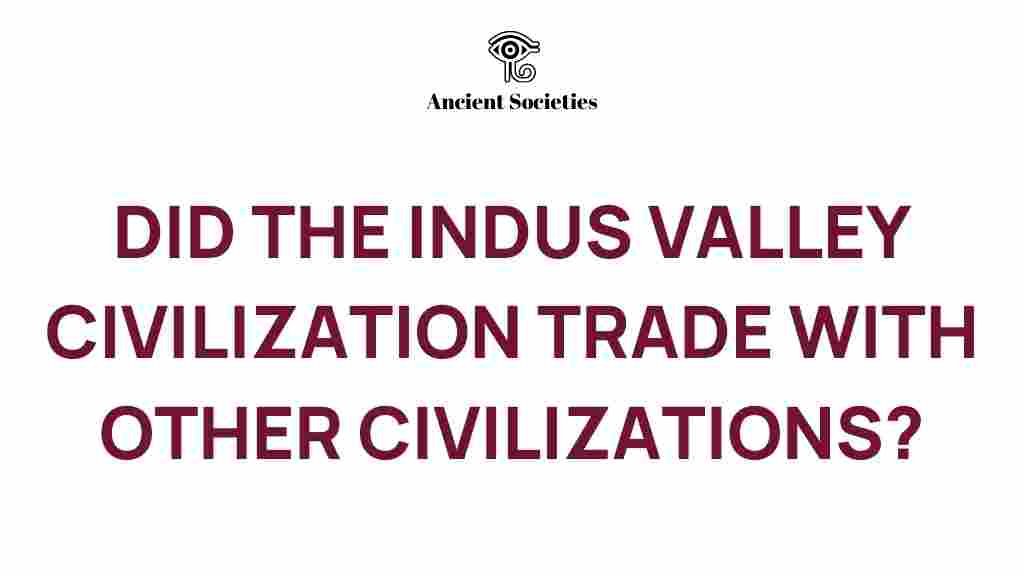Unraveling the Secrets of Indus Valley Civilization Trade Networks
The Indus Valley Civilization (IVC), one of the earliest urban cultures in the world, thrived between 3300 and 1300 BCE in what is now Pakistan and northwest India. Renowned for its advanced urban planning, sophisticated drainage systems, and impressive architecture, the Indus Valley is also notable for its extensive trade networks that connected it to various ancient civilizations. This article delves into the complexities of the trade of the Indus Valley, exploring its economy, culture, and the archaeological findings that illuminate its historical significance.
Understanding the Indus Valley Civilization
The Indus Valley Civilization is often regarded as a beacon of ancient innovation. Its cities, such as Mohenjo-Daro and Harappa, showcase remarkable planning and architecture. The civilization’s economy was robust, supported by agriculture, craftsmanship, and trade. To fully appreciate the trade networks, it is essential to understand the broader context of the IVC.
- Geographical Location: The IVC was strategically located along the fertile plains of the Indus River, providing access to both agricultural resources and trade routes.
- Urban Planning: The cities were designed with advanced urban planning, including grid patterns and sophisticated drainage systems that facilitated trade and commerce.
- Cultural Aspects: The culture of the Indus Valley is characterized by its unique artifacts, including seals, pottery, and jewelry, which played a significant role in trade.
Trade and Economy of the Indus Valley Civilization
Trade was a cornerstone of the Indus Valley economy, enabling the exchange of goods both locally and with distant regions. The trade networks of the IVC were highly developed, showcasing the civilization’s connectivity with other ancient civilizations such as Mesopotamia and Egypt.
Key Trade Goods
The economy of the Indus Valley was diverse, with various goods being traded:
- Textiles: Cotton was cultivated and woven into textiles, making it one of the first civilizations to use this material.
- Metals: The IVC traded in metals like copper, bronze, and gold, which were used to create tools and jewelry.
- Pottery: Distinctive pottery styles were developed, often decorated with intricate designs.
- Precious Stones: Semi-precious stones such as lapis lazuli, carnelian, and agate were crafted into various ornaments and traded extensively.
Trade Routes and Connectivity
The trade networks of the Indus Valley were extensive and facilitated the movement of goods across vast distances. Key trade routes included:
- Land Routes: The Indus Valley had well-established land routes connecting it to Persia and Central Asia.
- Maritime Routes: The civilization utilized maritime trade through the Arabian Sea, connecting it to Mesopotamia and the Gulf regions.
Archaeological Discoveries and Artifacts
The study of Indus Valley trade heavily relies on archaeological discoveries that provide insights into the economic and cultural practices of the civilization. Significant artifacts include:
- Seals: The IVC produced numerous seals featuring animals and script, often used for trade transactions and as symbols of authority.
- Weights and Measures: Standardized weights suggest a regulated system of commerce, indicating the importance of accurate trade.
- Trade Goods: Artifacts such as pottery and tools found in excavation sites illustrate the goods exchanged and the craftsmanship of the civilization.
Step-by-Step Process of Trade in the Indus Valley
Understanding the trade processes of the Indus Valley can be broken down into several key steps:
- Production: Goods were produced locally, including textiles, pottery, and metalwork.
- Standardization: The use of standardized weights and measures facilitated fair trade practices.
- Marketplaces: Local markets were established within urban centers, where goods were exchanged.
- Long-Distance Trade: Goods were transported over long distances, utilizing both land and sea routes.
- Exchange and Barter: Trade often involved barter systems where goods were exchanged without the use of currency.
Troubleshooting Trade Challenges
Despite its advanced trade networks, the Indus Valley civilization faced several challenges:
- Geopolitical Issues: Conflicts with neighboring civilizations could disrupt trade routes.
- Natural Disasters: Flooding and changes in the river patterns could impact agricultural production and trade.
- Resource Scarcity: Dependence on specific resources could pose risks if those resources became scarce.
To mitigate these challenges, the Indus Valley likely employed strategies such as diversifying trade partners and adapting to changing environmental conditions.
Cultural Exchange through Trade
Trade in the Indus Valley was not merely an economic activity; it was also a conduit for cultural exchange. The interaction with other civilizations led to:
- Artistic Influences: The exchange of artistic styles and techniques influenced the craftsmanship of the Indus Valley.
- Technological Innovations: New technologies, such as metalworking techniques from neighboring regions, were adopted.
- Religious Exchange: Trade facilitated the spread of religious beliefs and practices among different cultures.
Conclusion
The Indus Valley Civilization stands as a testament to the complexities of ancient trade networks. Its ability to connect with other ancient civilizations through commerce not only strengthened its economy but also enriched its culture. The archaeological findings, including artifacts and urban planning, reveal a society that was sophisticated and innovative in its approach to trade. By unraveling the secrets of the Indus Valley, we gain insight into how ancient civilizations interacted, adapted, and thrived.
For those interested in further exploring the connections between the Indus Valley and other ancient civilizations, you can check out this archaeology resource for more information. Additionally, to learn about the latest discoveries related to the Indus Valley, visit … .
This article is in the category Archaeology and created by AncientSocieties Team

2 thoughts on “Unraveling the Secrets of Indus Valley Civilization Trade Networks”